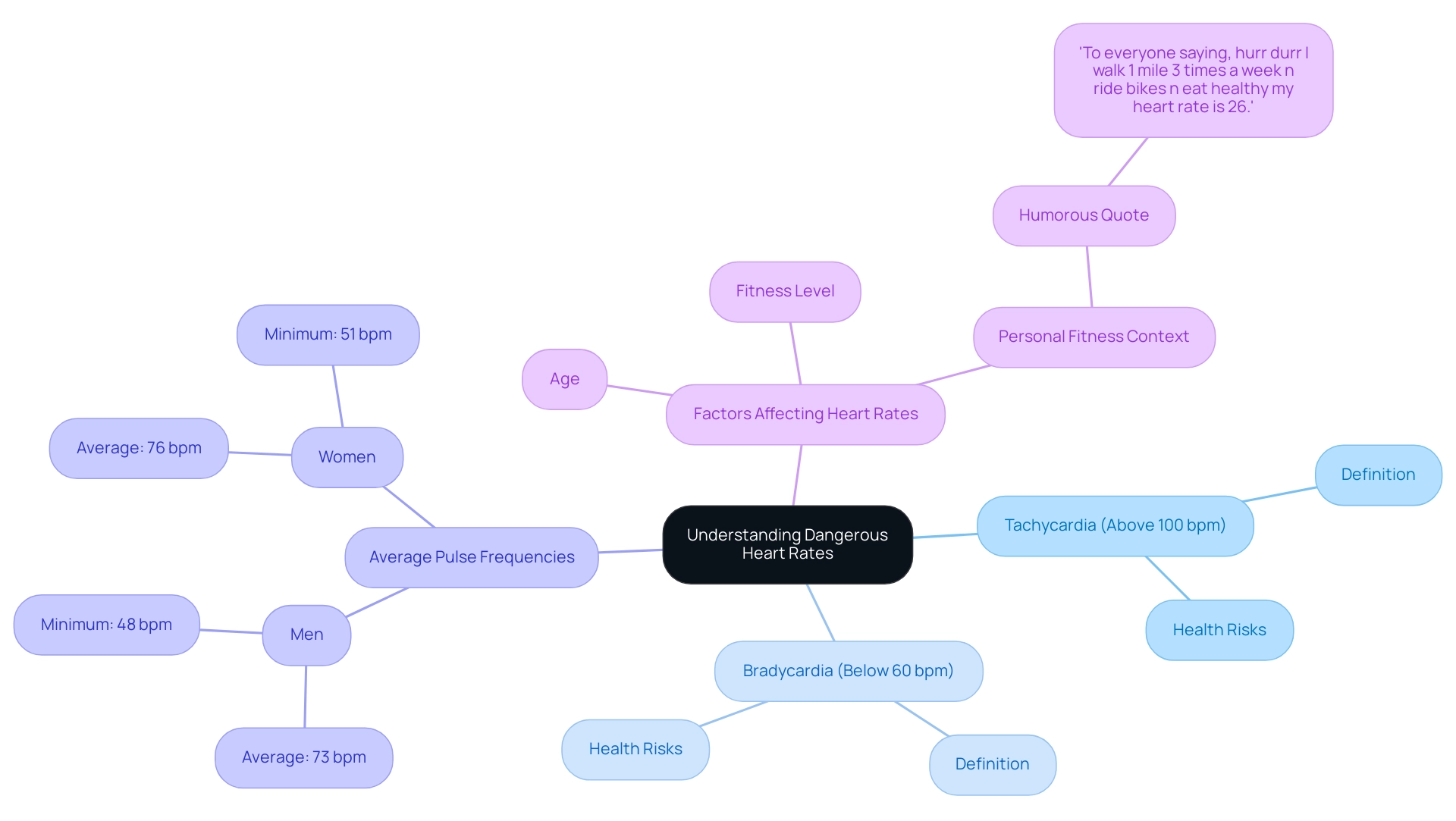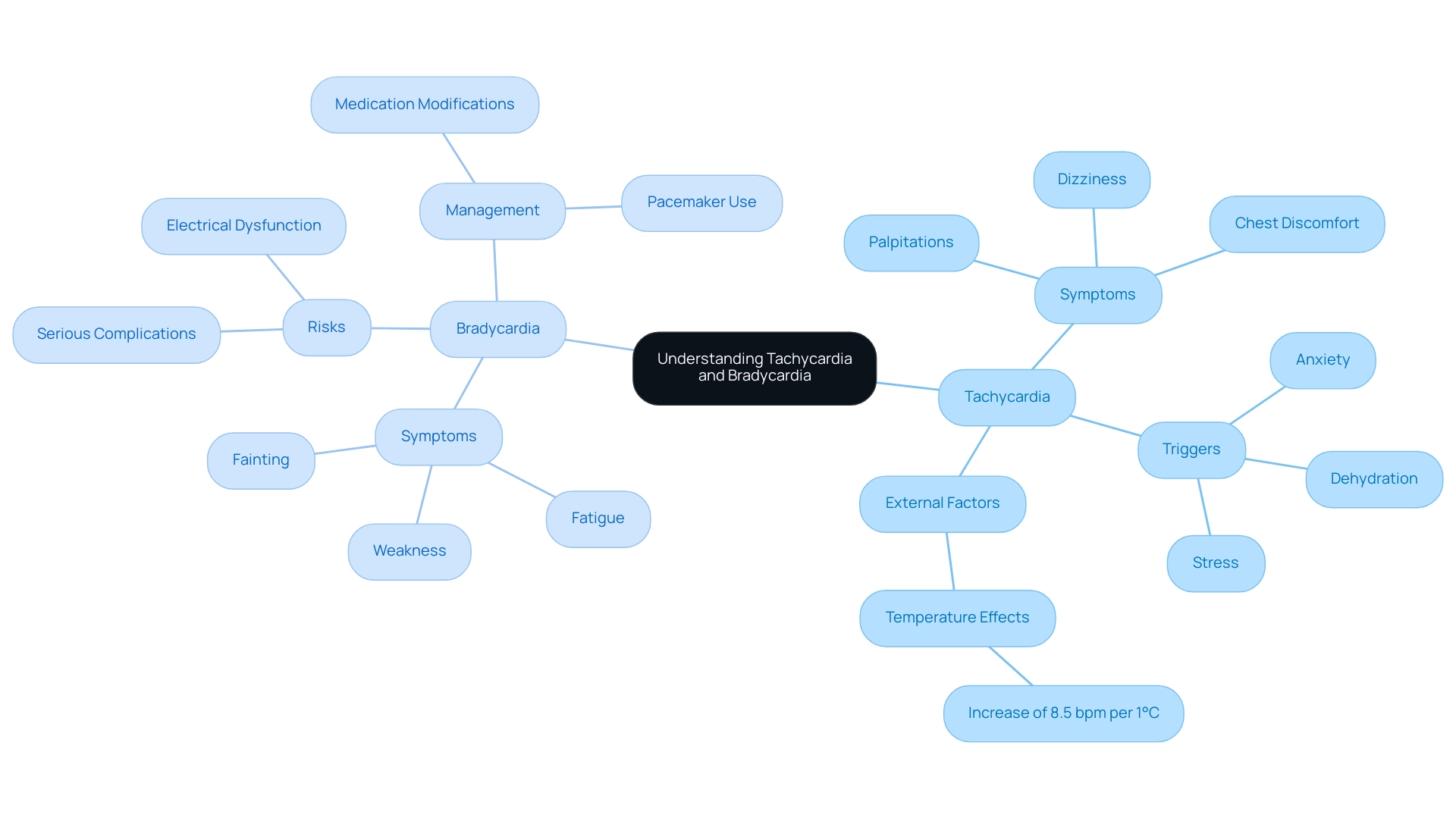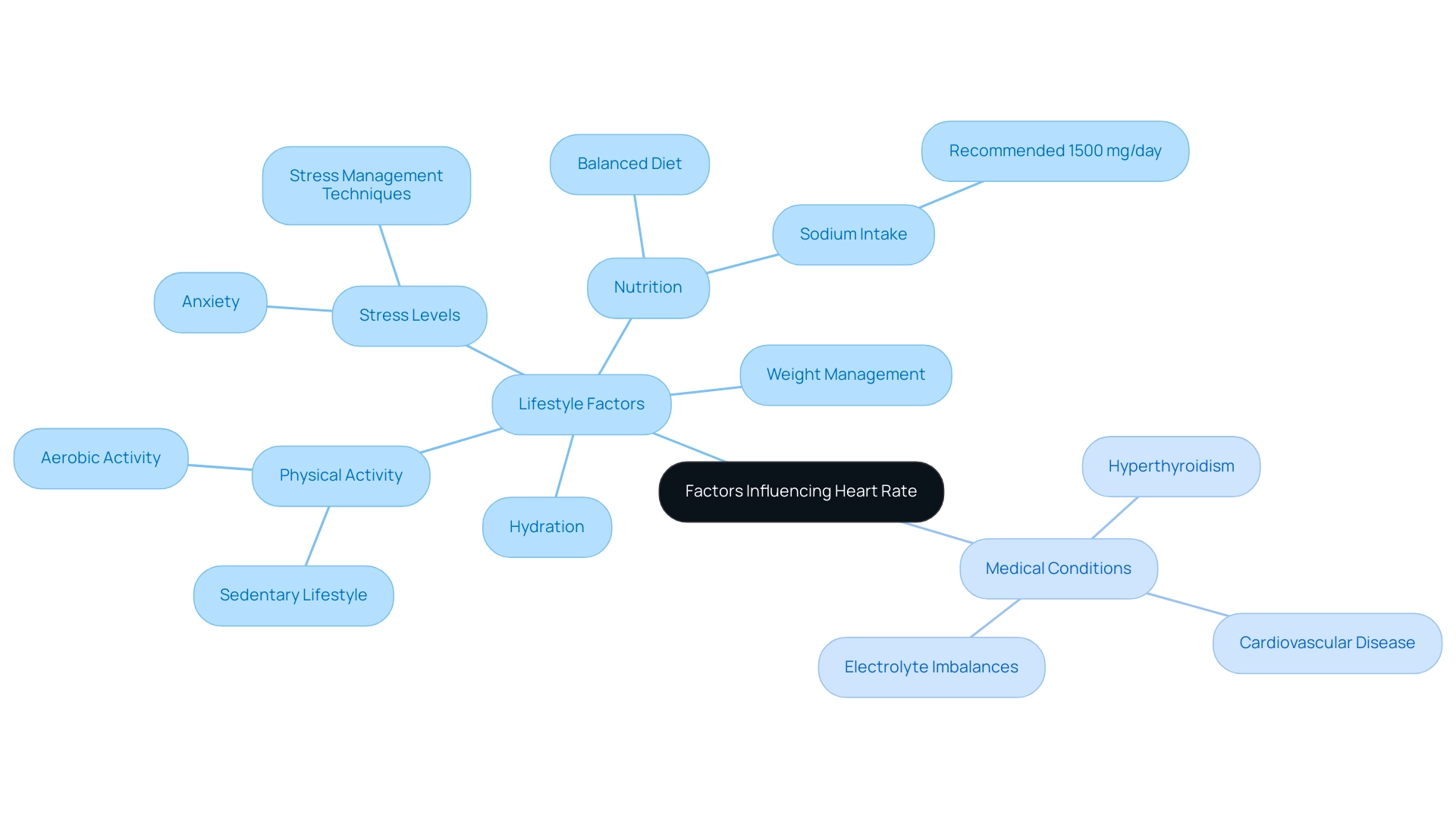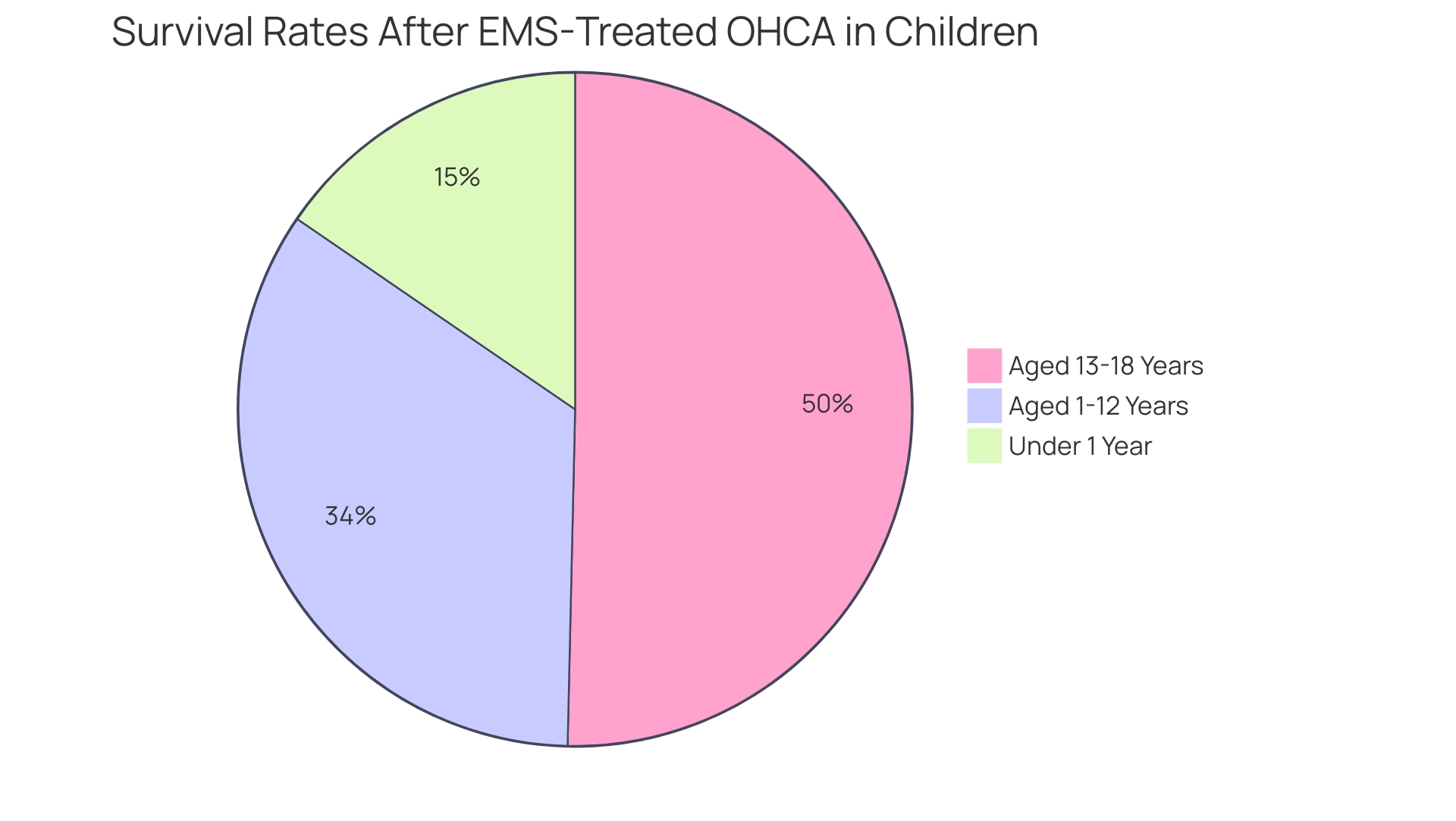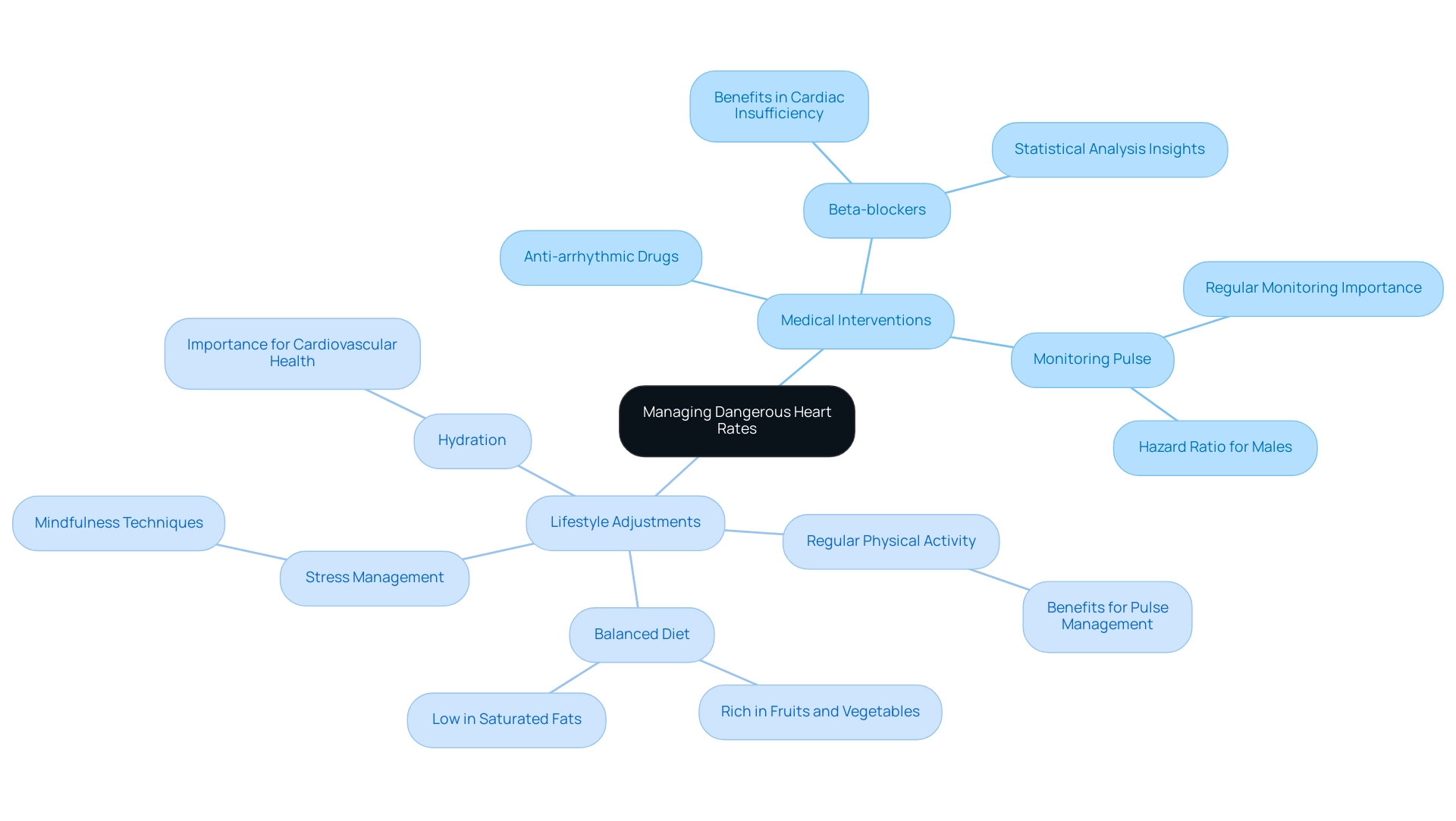Introduction
Heart rate is a crucial indicator of cardiovascular health, serving as a vital sign that can reveal much about an individual's overall well-being. Deviations from the normal range of 60 to 100 beats per minute can signal serious health concerns, such as tachycardia or bradycardia, each presenting distinct risks and symptoms. Understanding these conditions requires a comprehensive look at not only the physiological implications but also the lifestyle factors that influence heart rate.
This article delves into the complexities of heart rate management, exploring:
- The significance of lifestyle modifications
- The importance of recognizing alarming symptoms
- The critical interventions necessary for maintaining a healthy heart rhythm
By examining the interplay of medical conditions and lifestyle choices, readers will gain valuable insights into proactive measures for safeguarding their cardiovascular health.
1. Defining Dangerous Heart Rates: What You Need to Know
A harmful pulse is characterized as a pulse that deviates considerably from the typical range of 60 to 100 beats per minute for adults. Specifically, a pulse exceeding 100 beats per minute is classified as tachycardia, while a pulse below 60 beats per minute is termed bradycardia. Understanding what is a dangerous heart rate is crucial, as it can indicate underlying health issues and pose risks to cardiovascular well-being.
Recent studies have established reference ranges that indicate average pulse frequencies of:
- 73 bpm for men
- 76 bpm for women
With minimum pulse frequencies of:
- 48 bpm for men
- 51 bpm for women
It is also important to acknowledge that resting pulse frequencies can differ by age category, especially for women, with athletes frequently displaying lower resting pulse frequencies. For example, a resting pulse of 50 bpm may be standard for a 48-year-old long-distance athlete, emphasizing how personal fitness levels can affect pulse norms.
As one individual humorously noted, 'To everyone saying, hurr durr I walk 1 mile 3 times a week n ride bikes n eat healthy my heart rate is 26,' it’s clear that personal fitness context matters. Furthermore, a case study examining a healthy group subset has established
specific reference ranges for pulse frequencies, which are essential for evaluating cardiovascular status and identifying potential irregularities. Thus, analyzing pulse data within the framework of individual health is crucial for precise evaluation and for determining what is a dangerous heart rate and risk detection.
2. Understanding Tachycardia and Bradycardia: Risks and Symptoms
Tachycardia, which is defined by a pulse exceeding 100 beats per minute, prompts the question of what is a dangerous heart rate, and it often presents symptoms such as palpitations, dizziness, and chest discomfort. This condition can be triggered by various factors including stress, anxiety, dehydration, or pre-existing cardiovascular issues. Recent studies suggest that the occurrence of tachycardia may be affected by external factors, such as temperature, with pulse counts increasing by approximately
8.5 beats per minute for every 1 degree Celsius rise in temperature.
Additionally, research by Quer et al. (2020) emphasizes the variability in daily resting pulse, indicating that fluctuations can be substantial and should be observed carefully. In contrast, bradycardia is characterized by a pulse rate falling below 60 beats per minute and may manifest as fatigue, weakness, or fainting spells.
Although occasional instances of bradycardia may not necessitate treatment, severe cases can pose significant risks, particularly if they stem from dysfunction within the heart's electrical system. A notable case study illustrates this point:
- An 83-year-old woman with a history of diabetes and hypertension experienced severe bradycardia during the induction of anesthesia, ultimately requiring external pacing and the insertion of a permanent pacemaker for management.
This emphasizes the significance of prompt intervention, as severe bradycardia may necessitate modifications in medications or the use of a pacemaker, as pointed out in recent medical news.
Recognizing the symptoms of both tachycardia and bradycardia is crucial for timely intervention and effective management, as understanding what is a dangerous heart rate can prevent the serious complications that expert opinions, including those from A.N., H.W.-S., and C.H., suggest can arise from untreated cases. Their recognition of financial support from Fitbit Research also highlights the significance of technology in tracking pulse levels and managing these conditions effectively.
3. Factors Influencing Heart Rate: Lifestyle and Medical Conditions
A range of elements can greatly affect a person's pulse, including physical activity, stress levels, hydration, and overall health condition. Consistent aerobic activity is especially significant, as it has been demonstrated to reduce resting pulse levels, which is a sign of enhanced cardiovascular fitness. On the other hand, increased stress or anxiety can cause elevated pulse frequencies, prompting concerns about what is a dangerous heart rate and potentially resulting in conditions such as tachycardia.
Medical conditions such as hyperthyroidism, cardiovascular disease, and electrolyte imbalances further complicate pulse regulation. Dr. James M. Rippe, MD, founder of the Rippe Lifestyle Institute, notes that 'the construct of lifestyle medicine' seems particularly appropriate since these habits and practices are clearly part of a positive lifestyle, and their health-promoting benefits constitute a powerful approach to medicine and healing. Recent research on KSM-66 Ashwagandha supports its safe use for enhancing cognitive functions without negative effects on cardiovascular well-being.
However, it is crucial for individuals suffering from serious medical conditions or who have had recent surgery to consult their doctor before using it regularly to avoid any complications. This highlights its potential role in stress relief and overall well-being. Additionally, individuals can connect with certified nutritionists through Awesome Coffee, gaining personalized support for weight management, diabetes, and holistic wellness.
With our easy scheduling tool, you'll be connected with a Nutritionist within 24 hours, and every Awesome Coffee customer is guaranteed to pay $0 for their first nutrition coaching session. This perspective emphasizes the significance of understanding lifestyle factors in maintaining a healthy rhythm, especially when considering what is a dangerous heart rate.
Daily habits, including nutrition, physical activity, weight management, and stress reduction, play a critical role in determining cardiovascular well-being.
For example, the 2013 AHA/ACC Strategic Guidelines suggest decreasing sodium consumption to 1500 mg daily to aid blood pressure control, demonstrating how dietary modifications can positively influence cardiovascular health. Furthermore, daily habits significantly affect the likelihood of developing cardiovascular disease (CVD), as highlighted in various case studies. While some risk factors, such as age and family history, are uncontrollable, individuals can take proactive steps to reduce disease risk through manageable lifestyle changes.
With the AHA's 2020 Strategic Plan goals relying heavily on lifestyle interventions, it becomes evident that the integration of these factors is essential for maintaining a healthy cardiovascular system.
4. When to Seek Help: Recognizing Emergency Heart Rate Situations
It is crucial for individuals to seek prompt medical help upon noticing concerning symptoms such as chest pain, severe shortness of breath, fainting, or an irregular pulse, particularly when they are unsure about what is a dangerous heart rate. Such manifestations can signify serious medical conditions, including heart attacks or arrhythmias, which require prompt intervention. Notably, in 2015, the survival percentage to hospital discharge after EMS-treated nontraumatic out-of-hospital cardiac arrest (OHCA) for children was only 13.2%.
Survival percentages differed by age:
- 6.5% for children under 1 year
- 14.4% for those aged 1-12 years
- 21.2% for ages 13-18 years
This data underscores the critical nature of
timely medical intervention across different demographics. Awareness of these critical warning signs not only facilitates timely medical responses but also empowers individuals to act decisively, potentially averting life-threatening outcomes.
The case study titled 'OHCA Outcomes in Children' further illustrates the importance of recognizing symptoms and seeking help promptly.
5. Managing Dangerous Heart Rates: Treatment and Lifestyle Adjustments
Effectively managing pulse levels requires understanding what is a dangerous heart rate and necessitates a comprehensive strategy that integrates medical intervention with substantial lifestyle changes. Medications like beta-blockers and anti-arrhythmic drugs are often prescribed for conditions such as tachycardia and bradycardia, which raise the question of what is a dangerous heart rate when pulse frequencies exceed or drop below safe limits. For example, a recent research titled Pulse Frequency and Rhythm and the Benefit of Beta-Blockers in Patients With Cardiac Insufficiency emphasized the vital role of beta-blockers in enhancing outcomes for individuals with cardiac insufficiency and reduced ejection fraction by stabilizing pulse frequencies and rhythms.
This research emphasizes the possible
advantages of beta-blockers in controlling pulse effectively in individuals with severe cardiovascular issues. Alongside medicinal treatments, lifestyle changes are crucial in enhancing cardiovascular well-being. Routine physical activity is crucial; research indicates that individuals who participate in regular exercise gain substantial advantages, both regarding pulse management and overall cardiovascular wellness.
A balanced diet, rich in fruits and vegetables while low in saturated fats, is also essential for sustaining optimal cardiovascular function. Moreover, managing stress through mindfulness methods and ensuring sufficient hydration are proven strategies to improve cardiovascular health.
For individuals with pre-existing cardiac conditions, monitoring pulse regularly is crucial to determine what is a dangerous heart rate. Data indicate that male patients have a hazard ratio of 1.18 for cardiovascular risks, which highlights the increased vulnerability of this demographic and underscores the importance of vigilance in pulse management. According to Dipak Kotecha, Chief Investigator of the RATE-AF clinical trial, 'The statistical analysis conducted by an independent center highlighted key correlates of pulse frequencies exceeding 70 bpm, particularly in patients prescribed HR-lowering medications, which underscores the need for ongoing assessment and tailored interventions.'
Ultimately, the integration of these lifestyle changes with medical treatment not only helps to manage heart rates effectively but also contributes to long-term heart health.
Conclusion
Understanding and managing heart rate is essential for maintaining cardiovascular health. This article has highlighted the critical distinctions between dangerous heart rates, including tachycardia and bradycardia, along with their associated risks and symptoms. Recognizing these conditions is vital, as they can indicate serious underlying health issues that require prompt attention.
Lifestyle factors play a significant role in influencing heart rate. Regular physical activity, stress management, and a balanced diet are crucial for promoting a healthy heart rhythm. Additionally, awareness of alarming symptoms is imperative, as timely medical intervention can be lifesaving. The importance of monitoring heart rates and recognizing when to seek help cannot be overstated, especially in emergency situations.
In conclusion, taking proactive steps through lifestyle modifications and understanding the implications of heart rate variations can significantly enhance cardiovascular health. By integrating medical treatments with healthy habits, individuals can effectively manage their heart rates and reduce the risk of serious complications. Empowerment through knowledge and action is key to safeguarding heart health for the long term.
